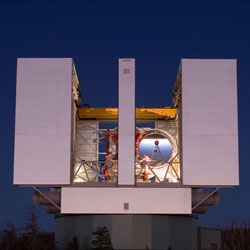onedomino
SCE to AUX
- Sep 14, 2004
- 2,677
- 482
- 98
The Hubble Space Telescope has rewritten the Astronomy and Cosmology text books. It is one of the most important scientific instruments ever. Now we are on the eve of something much better. Soon scientists all over the world will compete for time on the University of Arizona's Mt. Graham telescope; by far the largest optical telescope in the world.
World's Largest Optical Telescope Reveals First Image
http://www.osu.edu/news/lvl2_news_story.php?id=1240

The first images from the Large Binocular Telescope were released on the Web today, said a spokesman from Ohio State's Department of Astronomy, a partner in the project.
"We are thrilled with the quality of these images," added Patrick Osmer, chair in the department, and Distinguished Professor of Mathematical and Physical Sciences. "This is an important milestone in the process of reaching full functionality for the telescope."
According to an announcement from the Large Binocular Telescope Corporation, the target was an edge-on spiral galaxy (type Sb) known as NGC891 in the constellation Andromeda. This galaxy lies at a distance of 24 million light years from Earth. NGC891 is of particular interest because the galaxy-wide burst of star formation inferred from X-ray emission is stirring up the gas and dust in its disk, resulting in filaments of obscuring dust extending vertically for hundreds of light-years.
This image was created with just the first of the two 8.4-meter mirrors in place on the LBT, which is located on Mount Graham, AZ. During the coming winter months, the second mirror will be prepared for operation, and the super-thin coating of aluminum to make the mirror shiny will be deposited by scientists and researchers from Ohio State, who developed the technique. When both mirrors are in place and working together, the twin mirrors will offer astronomers a combined interferometric resolving power of a 23-meter telescope, according to Osmer.

The "first light" image from the $120 million dollar instrument.

